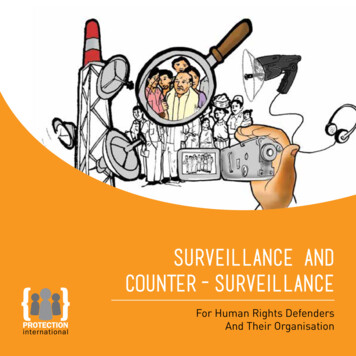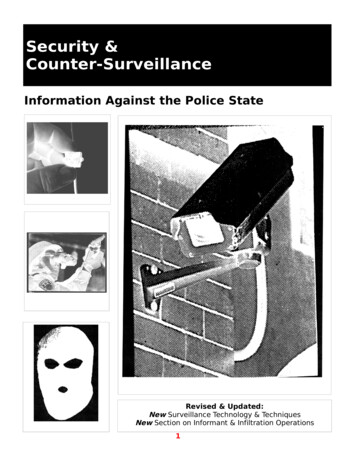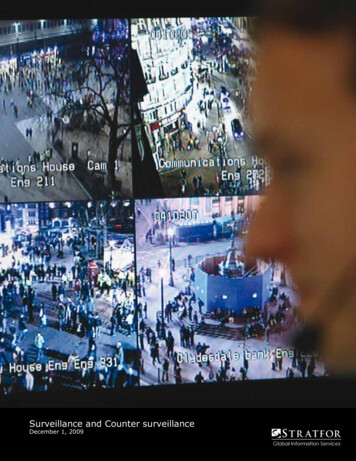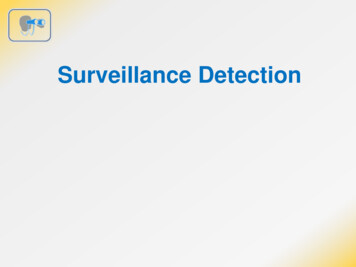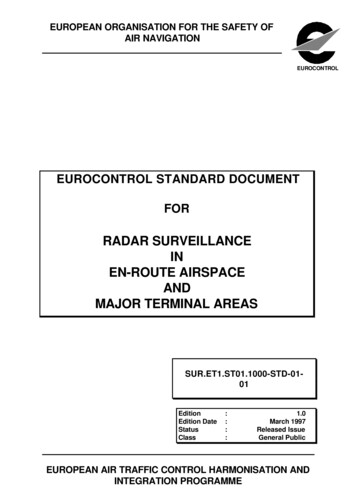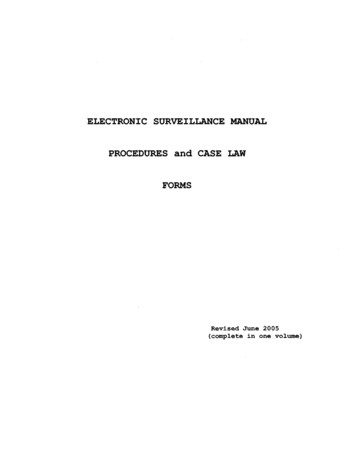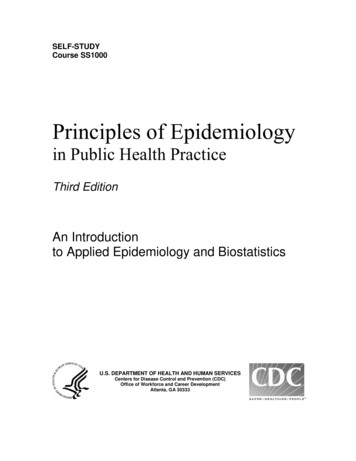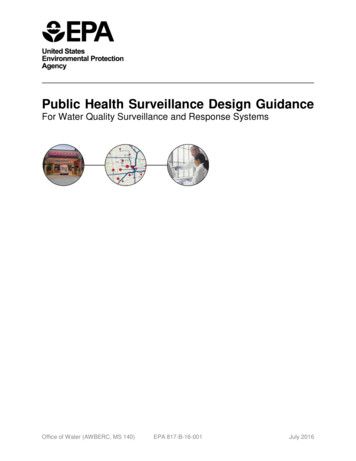
Transcription
Public Health Surveillance Design GuidanceFor Water Quality Surveillance and Response SystemsOffice of Water (AWBERC, MS 140)EPA 817-B-16-001July 2016
DisclaimerThe Water Security Division of the Office of Ground Water and Drinking Water has reviewed andapproved this document for publication. This document does not impose legally binding requirements onany party. The information in this document is intended solely to recommend or suggest and does notimply any requirements. Neither the U.S. Government nor any of its employees, contractors or theiremployees make any warranty, expressed or implied, or assume any legal liability or responsibility forany third party’s use of any information, product, or process discussed in this document, or represent thatits use by such party would not infringe on privately owned rights. Mention of trade names or commercialproducts does not constitute endorsement or recommendation for use.Version History: The 2019 version is the second release of the document, originally published in July2016. This release includes updated component names (Enhanced Security Monitoring was changed toPhysical Security Monitoring and Consequence Management to Water Contamination Response), anupdated version of Figure 1.1 that reflects the component name changes and includes the AdvancedMetering Infrastructure component, updated target capabilities, an updated Glossary, and updated links toexternal resources.Questions concerning this document should be addressed to WQ SRS@epa.gov or the following contact:Steve AllgeierU.S. EPA Water Security Division26 West Martin Luther King DriveMail Code 140Cincinnati, OH 45268(513) 569-7131Allgeier.Steve@epa.govi
AcknowledgementsThe document was developed by EPA’s Water Security Division, with additional support provided underEPA contract EP-C-15-012. Steve Allgeier, EPA, Water Security Division Adam Haas, General Dynamics Information Technology Darcy Shala, General Dynamics Information TechnologyPeer review of this document was provided by the following individuals: Jonathan Colvin, Drug and Poison Information Center, Cincinnati Children’s Hospital Kirsten Larson, Association of Public Health Laboratories Royal Law, Centers for Disease Control and Prevention Ami Patel, Philadelphia Department of Public Health David Travers, EPA, Water Security Division June Weintraub, San Francisco Department of Public Healthii
Table of ContentsLIST OF FIGURES. IVLIST OF TABLES . VABBREVIATIONS . VISECTION 1: INTRODUCTION.1SECTION 2: OVERVIEW OF PHS DESIGN .32.1 Generation of Public Health Datastreams .32.2 PHS Design Elements, Design Goals, and Performance Objectives .6SECTION 3: PARTNERSHIP WITH PUBLIC HEALTH .83.1 Establishing Relationships with Public Health Partners .83.2 Establishing a Joint Public Health and Utility Workgroup. 10SECTION 4: PUBLIC HEALTH SURVEILLANCE SYSTEMS . 124.1 Public Health Datastreams . 124.2 Public Health Surveillance Techniques . 194.3 Utility Role in Integrating Public Health Surveillance Capabilities into an SRS . 25SECTION 5: ALERT INVESTIGATION PROCEDURE . 315.1 Developing an Effective Alert Investigation Procedure . 315.2 Developing Investigation Tools . 365.3 Preparing for Real-time Alert Investigations . 37SECTION 6: PRELIMINARY PHS DESIGN . 40RESOURCES . 42REFERENCES . 45GLOSSARY . 48iii
List of FiguresFIGURE 1-1. SURVEILLANCE AND RESPONSE SYSTEM COMPONENTS .1FIGURE 2-1. EXAMPLE CHEMICAL CONTAMINATION SCENARIO (CARBAMATE PESTICIDE) .5FIGURE 2-2. EXAMPLE PATHOGEN CONTAMINATION SCENARIO (VIBRIO CHOLERAE) .5FIGURE 3-1. PROCESS FOR ENGAGING PUBLIC HEALTH PARTNERS WITH A POTENTIAL ROLE IN PHS .9FIGURE 4-1. PUBLIC HEALTH DATASTREAM ATTRIBUTE SUMMARY. 19FIGURE 4-2. OVERVIEW OF PUBLIC HEALTH SURVEILLANCE TECHNIQUES . 20FIGURE 4-3. EXCERPT FROM THE PUBLIC HEALTH SURVEILLANCE ASSESSMENT (HEALTH DEPARTMENT – SYNDROMICSURVEILLANCE DATASTREAMS) . 26FIGURE 5-1. EXAMPLE ALERT INVESTIGATION PROCESS FLOW DIAGRAM FOR VALID PHS ALERTS . 34FIGURE 5-2. EXAMPLE ALERT INVESTIGATION RECORD . 37iv
List of TablesTABLE 2-1. CONTAMINANT CLASSES THAT CAN BE DETECTED THROUGH PUBLIC HEALTH SURVEILLANCE .3TABLE 2-2. PUBLIC HEALTH DATASTREAMS AND THEIR LEVEL OF MEDICAL ASSESSMENT .4TABLE 2-3. DESIGN ELEMENTS FOR PUBLIC HEALTH SURVEILLANCE.6TABLE 2-4. COMMON SRS AND PHS DESIGN GOALS .6TABLE 2-5. EXAMPLE PHS PERFORMANCE OBJECTIVES .7TABLE 4-1. WATER CONTAMINATION INCIDENTS IDENTIFIED THROUGH CASE-BASED SURVEILLANCE . 22TABLE 4-2. SYNDROMES RELATED TO WATER CONTAMINATION . 23TABLE 4-3. COMMON SYNDROMIC SURVEILLANCE SYSTEMS . 24TABLE 4-4. EXAMPLE ASSESSMENT OF EXISTING PUBLIC HEALTH SURVEILLANCE SYSTEMS . 27TABLE 4-5. EXAMPLE STRATEGY FOR ADDRESSING GAPS IN PUBLIC HEALTH SURVEILLANCE CAPABILITIES. 30TABLE 5-1. EXAMPLE CAUSES OF PHS VALID ALERTS . 32TABLE 5-2. EXAMPLE OF GENERIC ROLES AND RESPONSIBILITIES FOR PHS ALERT INVESTIGATIONS . 35v
NPDSNRDMOTCPCCPHSRODSSRSAssociation of Public Health LaboratoriesCenters for Disease Control and PreventionCouncil of State and Territorial EpidemiologistsEmergency DepartmentElectronic Health RecordElectronic Medical RecordEmergency Medical ServicesU.S. Environmental Protection AgencyElectronic Surveillance System for the Early Notification of Communitybased EpidemicsNational Notifiable Diseases Surveillance SystemNational Poison Data SystemNational Retail Data MonitorOver-the-counter (medication sales)Poison Control CenterPublic Health SurveillanceReal-time Outbreak and Disease SurveillanceWater Quality Surveillance and Response Systemvi
Public Health Surveillance Design GuidanceSection 1: IntroductionThe U.S. Environmental Protection Agency (EPA) designed a Water Quality Surveillance and ResponseSystem (SRS) that employs multiple components to detect water quality incidents with potential publichealth and economic consequences. Figure 1-1 shows the components of an SRS grouped into twooperational phases, surveillance and response. Procedures guide the systematic investigation of anomaliesdetected by the surveillance components in order to identify its cause. If distribution systemcontamination is detected, response plans guide actions intended to minimize consequences. An SRS canbe implemented by drinking water utilities to improve their ability to detect and respond to undesirablewater quality changes. EPA intends the design of an SRS to be flexible and adaptable based on a utility’sgoals and the resources available to support implementation and operation of the system.Figure 1-1. Surveillance and Response System Components1
Public Health Surveillance Design GuidancePublic Health Surveillance (PHS) is one of five surveillance components of an SRS. The purpose of thisdocument is to provide guidance for designing the PHS component of an SRS. It is written for drinkingwater professionals who would be responsible for coordinating with public health partners to implementPHS. The guidance provides information about public health partners who may be engaged to supportPHS, includes an overview of available public health datastreams, and discusses common surveillancetechniques that can be leveraged to improve capability to monitor for illness due to exposure tocontaminated drinking water. It does not address the design of new public health surveillance systems,which would fall entirely within the domain of public health professionals.This document is organized into the following major sections: Section 2 provides information about the generation of public health datastreams and adescription of the PHS design elements that define the component. Guidance on developing eachdesign element is presented in the following sections. Section 2 also introduces the concepts ofdesign goals and performance objectives and explains how they inform the design of PHS. Section 3 provides guidance on creating a partnership with public health agencies. The sectionidentifies and describes common public health partners and provides guidance on methods toengage them.Section 4 describes available public health datastreams and common surveillance techniques, andprovides recommendations regarding how existing capabilities could be leveraged and potentiallyenhanced to support the goals of the PHS component of an SRS.Section 5 provides guidance on investigating PHS alerts. It describes attributes of an effectivealert investigation procedure, explains a utility’s role in the investigation of a PHS alert, describestools to support the investigation, and provides guidance on investigating alerts in real time.Section 6 describes the process for developing a preliminary design for the PHS component of anSRS.Resources presents a comprehensive list of documents, tools, and other resources useful for PHSimplementation. A summary and link to each resource is provided.References presents a comprehensive list of published literature cited within the document.Glossary presents definitions of terms used in this document, which are indicated by bold italicfont at first use in the body of the document.This document is written in a modular format in which the guidance provided on a specific topic is largelyself-contained, allowing the reader to skip sections that may not be applicable to their approach to PHS,or that include capabilities that have already been implemented. Furthermore, this document was writtento provide a set of core guidance principles that are sufficient to design the PHS component, whilepointing the reader to additional technical resources useful for a specific design task.2
Public Health Surveillance Design GuidanceSection 2: Overview of PHS DesignPublic health surveillance is the systematic collection, analysis, and interpretation of public health data forthe purpose of detecting public health incidents, or changes in the health status of a community, insufficient time to mitigate the consequences of the incident. Ongoing collection of public health data canalso be used to establish the baseline health status in a community, which is a useful benchmark for anypublic health initiative, including detection of drinking water contamination. Public health surveillanceoperates on the principle that individuals experiencing unusual or severe symptoms will seek healthcare.These actions create datastreams that can be monitored to detect signs of a public health incident.2.1 Generation of Public Health DatastreamsIn the context of an SRS, the purpose of PHS is to provide early detection of drinking watercontamination incidents and provide an opportunity to minimize adverse health impacts in exposedindividuals. Table 2-1 presents contaminant classes which can cause significant public healthconsequences if introduced into a water distribution system, example contaminants within those classes,and chief complaints (i.e., the primary symptom that a patient states as the reason for seeking medicalcare). The contaminant classes in Table 2-1 are separated into categories of delayed and rapid symptomonset, based on the delay between exposure to the contaminant and onset of acute symptoms.Table 2-1. Contaminant Classes that can be Detected through Public Health SurveillanceContaminant ClassesDelayed Symptom OnsetBacteriaVirusesProtozoaRapid SymptomOnsetToxins1ExampleContaminantsBacillus anthracisChills, fever, nausea, bloody vomitingCampylobacter spp.Headache, fever, abdominal pain, vomiting, bloody diarrheaLegionella pneumophilaMuscle pain, cough, fever, shortness of breath, nausea,vomiting, diarrheaSalmonella TyphiHeadache, abdominal pain, fatigue, fever, diarrheaVibrio choleraeLeg cramps, watery diarrhea, vomitingAdenovirusSore throat, sneezing, headache, cough, feverEnterovirusMuscle pain, cough, sneezing, wheezing, difficulty breathingNorovirusMuscle pain, abdominal pain, nausea, vomiting, waterydiarrhea, feverCryptosporidiumparvumAbdominal cramps, fever, nausea, vomiting, diarrheaGiardia lambliaAbdominal cramps, fatigue, nausea, vomiting, diarrheaBotulinum toxinMuscle weakness, blurred vision, vomiting, difficulty breathingChief Complaints1MicrocystinsHeadache, abdominal pain, vomiting, diarrhea, feverRicinNausea, vomiting, diarrheaHeavy metalsLeadAbdominal pain, headache, fatigue, memory loss, seizures,vomiting, constipationRadiochemicalsCesium-137Fatigue, fever, nausea, vomiting, diarrheaArsenic (III)compoundsSodium arseniteDifficulty swallowing, burning sensation in throat, thirst,dizziness, abdominal pain, vomiting, diarrheaCyanideCyanideHeadache, dizziness, confusion, nausea, vomitingMercurycompoundsMercuric chloridePain in mouth and throat, abdominal pain, difficulty breathing,vomiting, diarrheaPesticidesAldicarb, dichlorvosSweating, blurred vision, vomiting, diarrhea, difficulty breathingFor a specific contaminant, the chief complaint can vary by the route of exposure to contaminated water, which can includeingestion, dermal contact, and inhalation of aerosols or water vapor.3
Public Health Surveillance Design GuidanceIndividuals exposed to contaminated water may seek healthcare, possibly urgently, depending on the typeof symptoms and the rapidity of symptom onset. Healthcare seeking behavior may include calling 911,calling a Poison Control Center (PCC), calling a health advice hotline, requesting Emergency MedicalServices (EMS) response, making an appointment with a primary care physician, visiting a hospitalemergency department (ED), or purchasing an over-the-counter (OTC) medication. These actions becomepublic health datastreams through the creation of call logs, patient medical records, or pharmacymedication sales records. Often when individuals seek healthcare by visiting their primary care physicianor an ED, nurses or physicians will collect clinical samples and order a laboratory analysis. The results ofclinical laboratory analyses are another potential public health datastream.Public health datastreams are composed of numerous individual records (i.e., call logs, medical records,or medication sales) which contain specific case details (e.g., date, time, location, symptoms). Dependingon the specific healthcare seeking behavior that patients pursue when experiencing symptoms, they mayor may not be assessed by a medically trained professional before their information is captured and entersa datastream. For example, if a patient purchases OTC medication to alleviate their symptoms,information about the type of medication purchased, and the date, time, and location of the medicationsale can be captured. However, the patient would not be assessed by a medical professional when takingthis action. Conversely, if a patient schedules an appointment with their primary care physician,information about their health status would be assessed and captured during the visit by a medicalprofessional. Table 2-2 below presents the level of medical assessment that occurs for each datastreamdiscussed in this guidance.Table 2-2. Public Health Datastreams and their Level of Medical AssessmentPublic Health DatastreamAssessorLevel of Medical Assessment911 calls911 operatorNoneOTC medication salesSalespersonPCC callsPhysicians, nurses, and pharmacistsHealth advice hotline callsNursesEMS runsEmergency medical techniciansED casesPhysicians, physicians assistants, nursesHealthcare networksPhysicians, physicians assistants, nursesClinical laboratory resultsLaboratory analystsPhone assessmentIn-person assessmentTwo example drinking water contamination scenarios are presented below showing timelines associatedwith symptom onset, healthcare seeking behavior of an exposed individual, and the unique datastreamsthat are created by these behaviors. Figure 2-1 shows the timeline, symptoms, and healthcare seekingbehaviors of an individual who consumes water contaminated with a carbamate pesticide. In this example,the individual calls 911 following rapid onset of severe symptoms. An EMS unit is dispatched to theindividual’s home and transports them to the ED. The attending physician at the ED recognizes symptomssuggesting chemical poisoning and contacts the PCC to discuss treatment of the patient. The physicianalso collects a blood sample from the patient and orders a clinical laboratory test of the sample. Thissequence of healthcare seeking behaviors generates signals in the 911, EMS, ED, PCC, and clinicallaboratory results datastreams.4
Public Health Surveillance Design Guidance7:00AMPerson consumescontaminated water8:00AM9:00AMSymptom onset:sweating,nausea, blurredvisionSymptomsworsen: vomiting,diarrhea, difficultybreathing9:15AMIndividual calls911, requestsEMS transport911 data10:00AM11:00AMSeveraldays laterEMS deliverspatient to ED andcloses out recordEMS dataIndividual istreated at ED;ED consultsPCCED dataPCC dataClinicallaboratoryresults dataFigure 2-1. Example Chemical Contamination Scenario (Carbamate Pesticide)Figure 2-2 shows the healthcare seeking behaviors of an individual who consumes water contaminatedwith Vibrio cholerae. In this example, the individual initially purchases OTC medication to treatrelatively mild symptoms. Four days later symptoms worsen and the individual drives to the ED to seekurgent healthcare. The patient is assessed by the attending physician at the hospital and clinical laboratorytests are ordered on several clinical samples collected from the patient. This sequence of healthcareseeking behaviors generates signals in the OTC, ED, and clinical laboratory results datastreams. Under avariation of this scenario, the symptomatic individual might visit their primary care provider before goingto the ED, thus generating a signal in an additional datastream. The pathogen contamination scenariodiffered from the carbamate pesticide scenario with respect to the severity and timing of symptom onset,which resulted in a different sequence of health seeking behaviors.7:00AM2 days laterSymptom onset:nausea, stomachcramps, fever4 days laterIndividual drives topharmacy topurchase OTCmedicationPerson consumescontaminated waterSymptoms worsen:vomiting, waterydiarrhea,dehydration, legcramps10 days laterIndividual drivesto EDOTC dataED dataClinicallaboratoryresults dataFigure 2-2. Example Pathogen Contamination Scenario (Vibrio cholerae)5
Public Health Surveillance Design Guidance2.2 PHS Design Elements, Design Goals, and Performance ObjectivesDesign elements are the functional areas which comprise each component of an SRS. PHS consists ofthree design elements, which are described in Table 2-3.Table 2-3. Design Elements for Public Health SurveillanceDesign ElementDescriptionPartnership with PublicHealthStanding relationships between water utility personnel and public healthpartners who have developed a mutual understanding of each other’sresponsibilities and capabilities, and who are committed to supporting thegoals of PHS.Public Health SurveillanceSystemsSystems that support routine monitoring of public health datastreams forindicators of possible public health incidents. This includes medicalassessments of patients by healthcare professionals and monitoring ofpublic health datastreams such as: PCC calls, ED visits, EMS runs, healthadvice hotline calls, healthcare networks, clinical laboratory results, 911 calls,and OTC medication sales.Alert Investigation ProcedureA documented procedure for the timely and systematic investigation of PHSalerts, with clearly defined roles and responsibilities for each step of theprocess.An effective PHS component should have capability for each of the design elements listed in Table 2-3.Sections 3 through 5 of this document define a target capability for each of these design elements, whichif achieved, will result in a fully functional PHS component. However, the specific manner in which eachdesign element is implemented can vary, and it is possible to substantially improve PHS capabilitieswithout fully achieving the target capability for each design element. Likewise, PHS capabilities can beimplemented that exceed the target capability.The decision regarding how to implement each of these design elements and build the PHS component isinformed by design goals, which are the specific benefits a utility hopes to realize throughimplementation of an SRS. Design goals for PHS are derived from overarching design goals establishedfor the SRS, as illustrated in Table 2-4.Table 2-4. Common SRS and PHS Design GoalsSRS Design GoalPHS Design GoalDetect water contaminationincidentsProvide timely detection of possible water contamination incidents involvingcontaminants that produce symptoms with either rapid or delayed symptomonset.Strengthen interagencyrelationshipsWork collaboratively with public health partners to increase mutual awarenessof each other’s capabilities and to prepare to respond to any emergency.Coordinate on issues of mutualconcern to a utility and itspublic health partnersWork collaboratively with public health partners to address public healthinitiatives related to water quality and treatment, such as reducing the risk ofLegionella outbreaks in hospitals, and monitoring for lead exposure in children.Demonstrate the safety of thedrinking water supplyDemonstrate to the community and regulators that the utility is collaboratingwith public health partners to investigate drinking water as the possible cause ofpublic health incidents, and that the majority of public health incidents are notwaterborne.Additional factors to consider when designing PHS are performance objectives, which are metrics used togauge how well the SRS or its components meet the established design goals. While specific performanceobjectives must be developed in the context of a utility’s unique design goals, general performanceobjectives for an SRS are defined in the Water Quality Surveillance and Response System Primer and are6
Public Health Surveillance Design Guidancefurther described in Table 2-5 in the context of PHS. The table also includes a recommended benchmarkfor each performance objective. The objectives described below are for the performance of the overallPHS component.Table 2-5. Example PHS Performance ObjectivesPHS PerformanceObjectivesDescriptionRecommended BenchmarkContaminantcoverageThe number of contaminant classes that can be detected,which is dependent on the types of public health datamonitored through PHS.Detect contaminant classesthat produce rapid symptomonset and those that producedelayed symptom onsetSpatial coverageThe percentage of the distribution system service areamonitored by PHS, which is dependent on the public healthjurisdictions included in the monitored public healthdatastreams.100% of the distributionsystem service areaTimeliness ofdetection andinvestigationThe time between when healthcare seeking behaviors entera monitored datastream and when a PHS alert is generated,which is dependent on the delay between data generationand data analysis as well as the frequency of data analysis.This performance objective also considers the time to reacha conclusion from the investigation of an alert.24 hours or less to generatean alertOperationalreliabilityThe percentage of time that utility personnel are available tosupport the investigation of water contamination as thepossible cause of a PHS alert, which depends on theavailability of trained utility personnel and the informationmanagement systems used during an investigation.Availability of surveillancecapabilities and coverage ofPHS alert investigationresponsibilities 24/7/365Data qualityAvailability of sufficient data to support the investigation ofwater contamination as the possible cause of a PHS alert orpublic health incident, including utility data and public healthcase details. Also, the degree to which patients have beenassessed by a medically trained professional, as describedin Table 2-2 (i.e., none, phone assessment, in-personassessment).Utility data: water qualityparameter measurements,laboratory results, customerfeedbackThe ability to maintain and operate PHS using availableresources, which is dependent on the benefits derived fromthe component relative to the costs to maintain it.PHS alert investigationprocedures are incorporatedinto routine utility operationswithin 1 year of transitioning toreal-time operationSustainability2 hours or less to reach aconclusion from the alertinvestigationPublic health case details:demographics, symptoms,date/time of contact, locationwhere exposure occurredThe design goals and performance objectives established by a utility in collaboration with its publichealth partners provide the basis for designing PHS in a manner that meets the objectives and constraintsof both entities. The following sections present guidance on potential approaches to enhance capabilitiesfor each of the three PHS design elements described in Table 2-3. Additional background on the designelements, design goals, and performance objectives for PHS can be found in the Public HealthSurveillance Primer.7
Public Health Surveillance Design GuidanceSection 3: Partnership with Public HealthThis design element addresses the relationships between water utility personnel and public health partnerswith a role in PHS. It is the foundation for establishing notification and investigation procedures that arenecessary for effective detection and investigation of possible water contamination incidents.TARGET CAPABILITYA standing relationship has been established between a water utility and its public health partners, including the cityor county health department and the regional PCC.This section provides guidance on establishing partnerships with public health and covers the followingtopics: Subsection 3.1 provides guidance on establishing relationships with public health partners Subsection 3.2 provides guidance on establishing a joint public health and utility workgroup3.1 Establishing Relationships with Public Health PartnersUtilities should engage with the following two categories of public health partners to implement PHS: Health department. Health departments are established for different jurisdictions, such as thecity, county, and state. They are generally responsible for implementing various public healthinitiatives, monitoring the health of the community they serve, and enforcin
4.2 Public Health Surveillance Techniques . OTC Over-the-counter (medication sales) PCC Poison Control Center PHS Public Health Surveillance RODS Real-time Outbreak and Disease Surveillance SRS Water Qu
